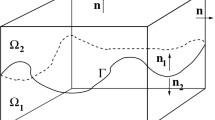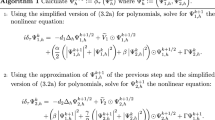Abstract
This article presents the first application of the Finite Calculus (FIC) in a Ritz-FEM variational framework. FIC provides a steplength parametrization of mesh dimensions, which is used to modify the shape functions. This approach is applied to the FEM discretization of the steady-state, one-dimensional, diffusion–absorption and Helmholtz equations. Parametrized linear shape functions are directly inserted into a FIC functional. The resulting Ritz-FIC equations are symmetric and carry a element-level free parameter coming from the function modification process. Both constant- and variable-coefficient cases are studied. It is shown that the parameter can be used to produce nodally exact solutions for the constant coefficient case. The optimal value is found by matching the finite-order modified differential equation (FOMoDE) of the Ritz-FIC equations with the original field equation. The inclusion of the Ritz-FIC models in the context of templates is examined. This inclusion shows that there is an infinite number of nodally exact models for the constant coefficient case. The ingredients of these methods (FIC, Ritz, MoDE and templates) can be extended to multiple dimensions
Similar content being viewed by others
References
Abramowitz M, Stegun IA (eds) (1972) Handbook of mathematical functions with formulas, graphs, and mathematical tables, 9th edn. Dover, NY
Ahmed MO, Corless RM (1997) The method of modified equations in Maple. In: Electronic proceedings of 3rd international IMACS conference on applications of computer algebra, Maui, Hawaii. PS version accessible at http://www.math.unm.edu/ACA/1997/Proceedings/odes/ Ahmed_paper.ps
Brezzi F, Hughes TJR, Marini LD, Russo A, Süli E (1999) A priori error analysis of residual-free bubbles for advection-diffusion problems. SIAM J Numer Anal 36:1933–1948
Brezzi F, Russo A (2000) Stabilization techniques for the finite element method. In: Spigler R (eds) Applied and industrial mathematics venice-2, 1998. Kluwer, Dordrecht, pp 47–58
Farhat C, Harari I, Franca L (2001) The discontinuous enrichment method. Comput Methods Appl Mech Eng 190:6455–6479
Farhat C, Harari I, Hetmaniuk U (2003) The discontinuous enrichment method for multiscale analysis. Comput Methods Appl Mech Eng 192:3195–3209
Felippa CA (2004) A template tutorial. In: Mathisen KM, Kvamsdal T, Okstad KM (eds) Computational mechanics: theory and practice, CIMNE, Barcelona, pp 29–68
Finlayson BM (1972) The methods of weighted residuals and variational principles. Academic Press, NY
Franca L, Farhat C, Lesoinne M, Russo A (1998) Unusual stabilized finite element methods and residual-free-bubbles. Int J Numer Methods Fluids 27:159–168
Franca L, Farhat C, Macedo AP, Lesoinne M (1997) Residual-free bubbles for the Helmholtz equation. Int J Numer Methods Eng 40:4003–4009
Griffiths D, Sanz-Serna J (1986) On the scope of the method of modified equations. SIAM J Sci Stat Comput 7:994–1008
Kolesnikov A, Baker AJ (1999) Efficient implementation of high order methods for the advection-diffusion equation. Proceedings of 3rd ASME/JSME joint fluids engineering conference. San Francisco, CA
Hairer E (1994) Backward analysis of numerical integrators and symplectic methods. Ann Numer Math 1:107–132
Hairer E, Lubich C, Wanner G (2002) Geometric numerical integration: structure preserving algorithms for ordinary differential equations. Springer, Berlin Heidelberg New York
Harari I, Hughes TJR (1990) Design and analysis of finite element methods for the Helmholtz equation in exterior domains. Appl Mech Rev 43:S366–S373
Harari I, Hughes TJR (1991) Finite element methods for the Helmholtz equation in an exterior domain: model problems. Comput Methods Appl Mech Eng 87:59–96
Harari I, Hughes TJR (1992) Galerkin/least-square finite element methods for the reduced wave equation with no reflecting boundary conditions in unbounded domains. Comput Methods Appl Mech Eng 98:411–454
Hirt CW (1968) Heuristic stability theory for finite difference equations. J Comp Phys 2:339–342
Hughes TJR (1995) Multiscale phenomena: Green’s functions, the Dirichlet-to-Neumann formulation, subgrid scale models, bubbles and the origins of stabilized methods. Comput Methods Appl Mech Eng 127:387–401
Kloeden PE, Palmer KJ (eds) (1994) Chaotic Numerics. Amer Math Soc, Providence, RI
Muir T (1960) Theory of determinants. Dover, NY
Lomax H, Kutler P, Fuller FB (1970) The numerical solution of partial differential equations governing convection. AGARDograph 146-70, NATO Advisory Group for Aerospace Research, Brussels
Oñate E, Garcí a J, Idelsohn SR, (1997) Computation of the stabilization parameter for the finite element solution of advective-diffusive problems. Int J Numer Methods Fluids 25:1385–1407
Oñate E, Garcí a J, Idelsohn SR (1998) Computation of the stabilization parameter for the finite element solution of advective-diffusive problems. In: Ladevèze P, Oden JT (eds) New advances in adaptive computer methods in mechanics. Elsevier, Amsterdam, NL
Oñate E (1998) Derivation of the stabilization equations for advective-diffusive fluid transport and fluid flow problems. Comput Methods Appl Mech Eng 151:233–267
Oñate Manzan M (1999) A general procedure for deriving stabilized space-time finite element methods for advective-diffusive problems. Int J Numer Methods Eng 31:203–207
Oñate E, Manzan M (2000) Stabilization techniques for finite element analysis of convection-diffusion fluid problems. In: Comini G, Sunden B (eds) Computerised analysis of heat transfer. WIT Press, Southampton, UK
Oñate E (2000) A stabilized finite element method for incompressible viscous flows using a finite increment calculus formulation. Comput Methods Appl Mech Eng 182:355–370
Oñate E, Garcí a J (2001) A finite element method for fluid-structure interaction with surface waves using a finite calculus formulation. Comput Methods Appl Mech Eng 191:635–660
Oñate E (2003) Multiscale computational analysis in mechanics using finite calculus: an introduction. Comput Methods Appl Mech Eng 192:3043–3059
Oñate E, Taylor RL, Zienkiewicz OC, Rojek J (2003) A residual correction method based on finite calculus. Eng Comput 20:629–658
Oñate E, Taylor RL, Zienkiewicz OC, Rojek J (2004) Finite calculus formulation for analysis of incompressible solids using linear triangles and tetrahedra. Int J Numer Methods Eng 59:1473–1500
Oñate E (2004) Possibilities of finite calculus in computational mechanics. Int J Numer Methods Eng 60:255–281
Oñate E, Garcí a J, Idelsohn SR (2004) Ship Hydrodynamics. In: Hughes TJR, de Borst R, Stein E (eds) Encyclopedia of computational mechanics, vol 2. Wiley, Chichester, pp 579–610
Oñate E, Miquel J, Hauke G (2005) A stabilized finite element method for the one-dimensional advection diffusion-absorption equation using finite calculus. Comput. Meth. Appl. Mech. Eng. accepted
Oñate E, Felippa CA (2005) Variational formulation of the finite calculus equations in solid mechanics, CIMNE Report (in preparation)
Park KC, Flaggs DL (1984) A Fourier analysis of spurious modes and element locking in the finite element method. Comput Methods Appl Mech Eng 42:37–46
Park KC, Flaggs DL (1984) An operational procedure for the symbolic analysis of the finite element method. Comput Methods Appl Mech Eng 46:65–81
Richtmyer RL, Morton, KW (1967) Difference methods for initial value problems, 2nd edn. Interscience, Wiley, NY
Roache PJ (1970) Computational fluid mechanics. Hermosa, Albuquerque, NM
Stuart AM, Humphries AR (1996) Dynamic systems and numerical analysis. Cambridge University Press, Cambridge, UK
Tong P (1969) Exact solution of certain problems by the finite element method. J AIAA 7:179–180
Vujanovic BD, Jones SE (1989) Variational methods in nonconservative phenomena. Academic Press, NY
Waltz JE, Fulton RE, Cyrus NJ (1968) Accuracy and convergence of finite element approximations. In: Proceedings of 2nd conference on matrix methods in structural mechanics. WPAFB, Ohio. AFFDL TR 68-150, pp 995–1028
Warming RF, Hyett BJ (1974) The modified equation approach to the stability and accuracy analysis of finite difference methods. J Comput Phys 14:159–179
Wilf HS (1991) Generating functionology. Academic Press, NY
Wilkinson JH (1961) Error analysis of direct methods of matrix inversion. J ACM 8:281–330
Wilkinson JH (1963) Rounding errors in algebraic processes. Prentice-Hall, Englewood Cliffs, NJ
Wilkinson JH (1965) The algebraic eigenvalue problem. Oxford University Press, Oxford, UK
Zienkiewicz OC, Taylor RE (1988) The finite element method, vol I, 4th edn. McGraw-Hill, London, UK
Author information
Authors and Affiliations
Corresponding author
Rights and permissions
About this article
Cite this article
Felippa, C.A., Oñate, E. Nodally exact Ritz discretizations of 1D diffusion–absorption and Helmholtz equations by variational FIC and modified equation methods. Comput Mech 39, 91–111 (2007). https://doi.org/10.1007/s00466-005-0011-z
Received:
Accepted:
Published:
Issue Date:
DOI: https://doi.org/10.1007/s00466-005-0011-z




